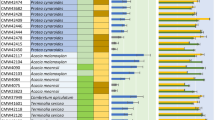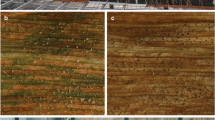Abstract
Apothecia of the eyespot fungus,Tapesia yallundae, were found on 0–18% of straws in plots of wheat stubble in February–March 1994. The fungicides carbendazim, prochloraz or carbendazim plus prochloraz had been applied repeatedly to the same plots in each of the previous 9 years in which successive wheat crops had been grown. The factors most strongly correlated with the incidence of apothecia were the incidence and severity of eyespot in the preceding wheat crop and the frequency of carbendazim-resistant W-type fungus in populations recovered from that wheat crop. Plots treated with carbendazim, which had previously had more disease and more resistance to carbendazim in the pathogen population relative to untreated plots, therefore yielded most apothecia. Plots treated with prochloraz, which had selected for predominantly R-type fungus and decreased eyespot, yielded few apothecia. Single-ascospore isolates were all of the W-type and were more frequently carbendazim-sensitive than expected, except those from plots treated only with carbendazim. None showed decreased sensitivity to prochloraz. The implications of applying fungicides regularly for controlling eyespot on the capability of the eyespot fungus for genetic variation through sexual reproduction are discussed.
Similar content being viewed by others
References
Ansell DJ and Tranter RB (1992) Set-aside: in Theory and Practice. University of Reading Department of Agricultural Economics, Reading
Bateman GL (1990) Comparison of the effects of prochloraz and flusilazole on foot rot diseases and on populations of the eyespot fungus,Pseudocercosporella herpotrichoides, in winter wheat. Zeitschrift für Pflanzenkrankheiten und Planzenschutz 97:508–516
Bateman GL and Fitt BDL (1991) Effects of fungicides on eyespot in five successive crops of winter wheat in plots with different initial or fungicide-selected populations ofPseudocercosporella herpotrichoides. Crop Protection 10: 479–484
Bateman GL, Fitt BDL, Creighton NF and Hollomon DW (1990) Changes in populations ofPseudocercosporella herpotrichoides in successive crops of winter wheat in relation to initial populations and fungicide treatments. Crop Protection 9: 135–142
Bateman GL, Landau S and Welham SJ (1995) Sensitivity to prochloraz in populations of the eyespot fungus,Pseudocercosporella herpotrichoides, in relation to fungicide treatments and their efficacy in continuous winter wheat. Annals of Applied Biology 126: 235–247
Creighton NF and Bateman GL (1991) Problems in identifying pathogenicity types ofPseudocercosporella herpotrichoides by colony morphology arising from the source and concentration of the nutrient agar. Mycological Research 95: 253–254
Dyer PS, Bateman GL, Lucas JA and Peberdy JF (1994a) Seasonal development of apothecia of the cereal eyespot pathogenTapesia yallundae on straw. Annals of Applied Biology 125: 489–500
Dyer PS, Nicholson P, Rezanoor HN, Lucas JA and Peberdy JF (1993) Two-allele heterothallism inTapesia yallundae, the teleomorph of the cereal eyespot pathogenPseudocercosporella herpotrichoides. Physiological and Molecular Plant Pathology 43: 403–414
Dyer PS, Papaikonomou M, Lucas JA and Peberdy JF (1994b) Isolation of R-type progeny ofTapesia yallundae from apothecia on wheat stubble in England. Plant Pathology 43: 1039–1044
Dyer PS, Lucas JA (1995) Incidence of apothecia ofTapesia yallundae at set-aside sites in England and sensitivity of the ascospore offspring to the fungicides benomyl and prochloraz. Plant Pathology (in press)
Hayter JBR (1990) The Genetics and Molecular Biology ofErysiphe graminis DC. f. sp.hordei Marchal. PhD thesis, University of Cambridge
Hoare FA, Hunter T and Jordan VWL (1986) Influence of spray programmes on development of fungicide resistance in the eye-spot pathogen of wheat,Pseudocercosporella herpotrichoides. Plant Pathology 35: 506–511
Hunter T (1989) Occurrence ofTapesia yallundae, teleomorph ofPseudocercosporella herpotrichoides, on unharvested wheat culms in England. Plant Pathology 38: 598–603
King AC (1990) First record ofTapesia yallundae as the teleomorph ofPseudocercosporella herpotrichoides var.acuformis, and its occurrence in the field in the Federal Republic of Germany. Plant Pathology 39: 44–49
Migeon JL, Mathon MP and Chudzicki AM (1993) Le prochloraze dans le nord de la France. Premiers cas de résistance pratique du piétin-verse du blé (Pseudocercosporella herpotrichoides). Mededelingen de Faculteit Landbouwwetenschappen Rijksunivesitat, Gent 58: 1401–1409
Polley RW, Slough JE and Jones DR (1993) Winter Wheat Disease Survey Report 1993. CSL/ADAS, 44pp
Wallwork H (1987) ATapesia teleomorph ofPseudocercosporella herpotrichoides, the cause of eyespot of wheat. Australasian Plant Pathology 16: 92–93
Author information
Authors and Affiliations
Rights and permissions
About this article
Cite this article
Bateman, G.L., Dyer, P.S. & Manzhula, L. Development of apothecia ofTapesia yallundae in contrasting populations selected by fungicides. Eur J Plant Pathol 101, 695–699 (1995). https://doi.org/10.1007/BF01874874
Accepted:
Issue Date:
DOI: https://doi.org/10.1007/BF01874874




